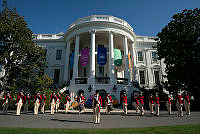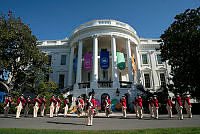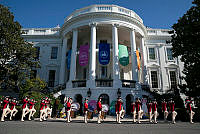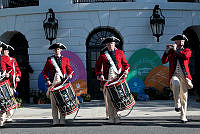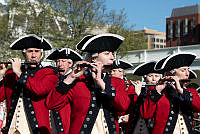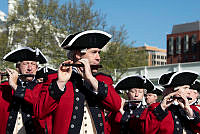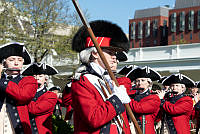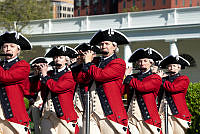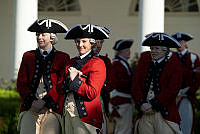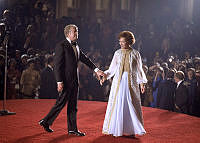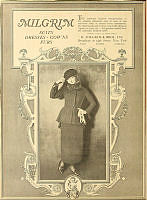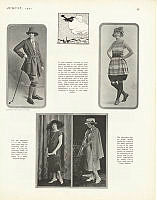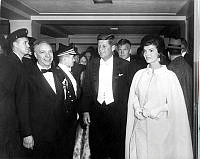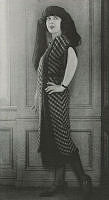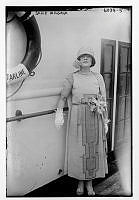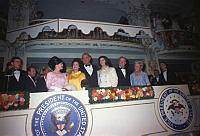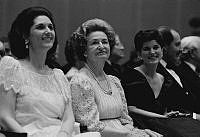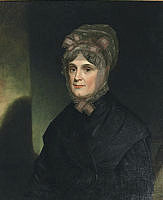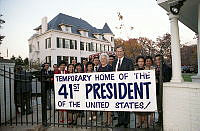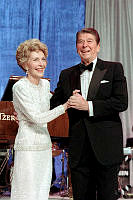Rubenstein Center Scholarship
The Revolutionary Inauguration of Thomas Jefferson

This portrait of Thomas Jefferson was painted by Rembrandt Peale in 1800, when Jefferson served as vice president to John Adams, whom he would succeed in the presidency in 1801.
White House Historical Association/White House CollectionNearly two decades after his election to the presidency, Thomas Jefferson elaborated on the significance of this triumph to his friend Spencer Roane. The “revolution of 1800,” he wrote, “was as real a revolution in the principles of our government as that of 76.” This transformation was “not effected indeed by the sword…but by the rational and peaceable instrument of reform, the suffrage of the people.”1 During his retirement Jefferson frequently reflected on his legacy and the partisanship that forged the two-party system of the early Republic. Perhaps it was these shared political experiences that permitted him and John Adams to revive their friendship after Jefferson left the presidency. In their later years these revolutionaries corresponded regularly, exchanging opinions and warm memories of their past deeds, making it difficult to imagine that they had once been rivals and bitter enemies.
The political divide between Federalists and Republicans grew significantly once George Washington left the presidency in 1797, and it was no secret that Vice-President Jefferson would challenge Adams’s re-election bid in 1800. Unlike modern elections, presidential candidates did not personally campaign for votes; rather their supporters championed them and criticized their political opponents. These battles took place in print as Jefferson enthusiasts lambasted the Federalists, constantly characterizing them as lovers of aristocracy, monarchy, and pawns of the British crown. Federalists and their proponents fought back, branding Republicans as radicals akin to the Jacobin leaders of the French Revolution. One Federalist writer named “Burleigh” reminded readers that while the “democrats” claimed to be “the friends of the people; and Mr. Jefferson the man of the people,” so too were Maximilien Robespierre, Jean-Paul Marat, and Napoleon Bonaparte. Burleigh warned citizens that these Jeffersonian demagogues, like their French counterparts, would only use their newfound powers to persecute and destroy their enemies.2 As both sides vilified their opponents and predicted post-election violence, citizens anxiously awaited the results.

This portrait of John Adams was painted by Edgar Parker in 1878. Parker based the image on an earlier portrait of Adams painted by acclaimed portraitist Gilbert Stuart. Adams served as George Washington's vice president. He would succeed Washington as president on March 4, 1797 and serve until March 4, 1801.
White House Historical Association/White House CollectionIn mid-December President Adams learned that he had received fewer votes than either of the Republican candidates, Jefferson and Aaron Burr. Two days before Christmas the electoral tallies revealed a tie between the two frontrunners, throwing the election into the House of Representatives. The Federalists had lost the presidency and seats in both legislative chambers, but the outcome of the election remained in their hands. Eager to deny Aaron Burr the presidency, Alexander Hamilton labored to shift votes in favor of Jefferson.
On February 17th Jefferson captured the majority of votes on the thirty-sixth ballot, sparking both celebration and apprehension across the country. Many citizens wondered whether their representatives would transfer power between the parties or refuse to concede authority. Resistance to Republican rule came only in the form of federal appointments, as Adams worked furiously to employ Federalist customs officers, judges, and justices of the peace. On the day of Jefferson’s inauguration, President Adams quietly vacated the President’s House at four in the morning. Several historians have suggested that Adams left early because he believed his presence might provoke violence; others reasoned that Jefferson never invited him to attend the ceremony and Adams, too proud to ask his successor, departed as a courtesy. One scholar even speculated that Adams simply needed a full day’s time to make the forty-mile trip to Baltimore before heading home to Massachusetts. Regardless of motive, Adams’s decision to accept the election results and yield power peacefully set an important precedent for future presidential transitions.3
While there was little time to plan an inauguration, this predicament did not seem to bother Jefferson. As the first president to take the oath in the new national capital, he seized the opportunity to define ceremonial practices that reflected his beliefs in republican simplicity. He took up residence at Conrad and McMunn’s, a boarding house just south of the Capitol. He informed representatives that he would take the oath on Wednesday the fourth at twelve o’clock in the Senate Chamber.4 On inauguration morning around 10 o’clock companies of Alexandria riflemen and artillery gathered to parade “in the front of the President’s lodgings.” Shortly before noon President-elect Jefferson, accompanied by fellow citizens, the militia officers, and members of Congress, made his way on foot to the Capitol. One correspondent remarked that Jefferson’s “dress was, as usual, that of a plain citizen, without any distinctive badge of office.”5 As he entered the Capitol the artillery company fired sixteen shots, one for each state of the Union, signifying the arrival of the new chief executive. Once inside, members rose to welcome their new president.6

This photograph from the late nineteenth century is the former home of Thomas Law. Law, who was married to Martha Washington's granddaughter Elizabeth Parke Custis, was a major real estate investor in the emerging national capital. Conrad and McMunn operated out of the Law property at New Jersey Avenue and C Street, opening in November 1800.
Published in Allen C. Clark, Thomas Law: A Biographical Sketch. Washington D.C: W.F. Roberts Press, 1900, 27.Jefferson sat in the presiding chair of the Senate and waited for the crowd of attendees to quiet themselves. After several moments of silence he gave a brief speech that lasted less than ten minutes. Jefferson regretted the divisiveness of the election but welcomed its disagreements and debate, as these dialogues encouraged citizens “to think freely, and to speak and to write what they think.” He laid out over a dozen principles that would guide his administration: first, equal justice and treatment of all men; last, freedom of religion, freedom of the press, habeas corpus, and the right to a trial by jury. These individual liberties, secured by the government, were the only true means to “peace, liberty, and safety.” Calling for national unity and healing, he reminded those present that “[w]e are all Republicans: we are all Federalists.”7
Jefferson’s conciliatory tone surprised Federalists, who had expected more of the same rancor that defined the election of 1800. The new president solemnly concluded his speech and approached the clerk’s table where Chief Justice John Marshall, an avowed Federalist and “midnight” appointee of Adams, administered the oath of office. Another round of artillery erupted outside as Jefferson returned to Conrad and McMunn’s with Vice-President Aaron Burr, Chief Justice Marshall, and the heads of the departments in tow. After lunch Jefferson received visitors, dignitaries, and friends into the afternoon while citizens celebrated outside. The evening featured a dinner for the president, a “discharge of sixteen guns at sunset,” illuminations, and the singing of patriotic songs. Four years later his second inauguration mirrored his first in many ways, emphasizing the republican ethos that defined his presidency.8

A view of the Capitol of Washington before it was burnt in 1814 by the British. This famous watercolor view by William Birch shows the only section of the Capitol that had been completed when the government moved to Washington in 1800. Workmen are cutting stones in the left foreground, and the city can be seen in the distance on the right.
Library of CongressWhile Jefferson’s inaugurations were modest compared to those of modern presidents, he did establish two important traditions that endure today. First, he incorporated the Marine Band into presidential festivities. A music aficionado himself, Jefferson asked the company to play the July 4th celebration at the President’s House in 1801. The band would go on to play New Years’ Day and Fourth of July receptions throughout his administration. They have performed at every inauguration since Jefferson’s time, earning the nickname “The President’s Own.”9
The other tradition began with Jefferson’s second inauguration in 1805. After the swearing-in ceremony at the Capitol, the president made his way home down Pennsylvania Avenue. According to Augustus Foster, a member of the British legation, a “collection of people” accompanied Jefferson back to the President’s House “in procession on the road.” This spontaneous march is considered the first inauguration parade down Pennsylvania Avenue in the nation’s capital. While inauguration ceremonies evolved significantly since the early Republic, these Jeffersonian traditions helped define presidential customs and continue to shape how we celebrate our elected officials.10

This photograph shows a black-and-white engraving published in 1834 to portray Washington, D.C. and the west front of the U.S. Capitol grounds as they were in 1800. It includes the west end of the grounds and Pennsylvania Avenue, lined with poplar trees.
Library of Congress













